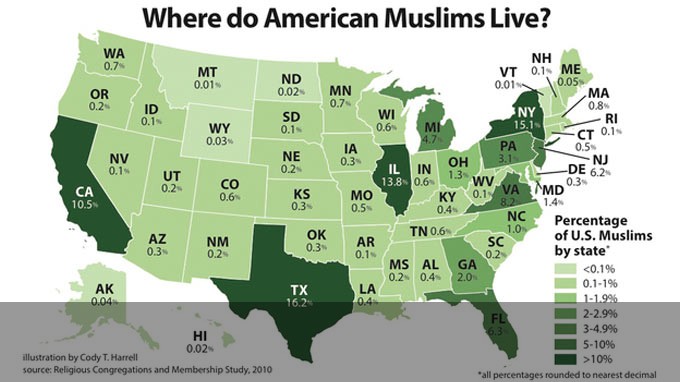Map of American Muslim Population Distribution


Alex Cartwright
Senior Cartographer & GIS Specialist
Alex Cartwright is a renowned cartographer and geographic information systems specialist with over 15 years of experience in spatial analysis and data...
Geographic Analysis
What This Map Shows
The visualization titled "Where do American Muslims live" provides a detailed representation of the geographical distribution of Muslims across the United States. By using color gradients and markers, the map highlights areas with significant Muslim populations, allowing viewers to easily identify regions where this religious and cultural community is more concentrated. This map serves as an essential tool for understanding the demographic layout and the cultural diversity that exists within the U.S.
Deep Dive into American Muslim Demographics
The Muslim population in the United States is a vibrant tapestry of cultures, ethnicities, and backgrounds. It is estimated that there are approximately 3.5 million Muslims in the U.S., making up about 1.1% of the total population. Interestingly, this figure has been steadily increasing due to immigration and higher birth rates among Muslim families.
The diversity within the American Muslim community is striking. The population includes individuals from various ethnic backgrounds, including Arab, South Asian, African American, and Caucasian Muslims. This diversity enriches the cultural landscape of American society, contributing to a more pluralistic environment.
Many American Muslims are concentrated in metropolitan areas, which provide better access to community resources, religious centers, and social networks. For instance, cities like New York, Los Angeles, and Chicago stand out as major hubs for Muslims. In New York City alone, it is estimated that there are over 800,000 Muslims, representing various ethnicities and traditions. The presence of mosques is a visible indicator of this population, with over 200 mosques scattered throughout the city.
Moreover, Middle Eastern and South Asian immigrants have played a significant role in shaping the demographics. States such as California and Texas have seen substantial increases in their Muslim populations, largely due to immigration from countries like Afghanistan, Iraq, and Pakistan. Interestingly, many Muslims are also making their homes in smaller cities and suburban areas, expanding the community's reach beyond traditional urban centers.
Regional Analysis
Breaking down the map, we can observe distinct regional patterns in the distribution of American Muslims. The Northeast region, particularly around New York and New Jersey, hosts a high concentration of Muslims, often due to historical immigration patterns and established communities. The New York metropolitan area is known for its cultural diversity, making it a welcoming place for immigrants from various backgrounds.
In contrast, the Midwest, with cities like Detroit and Chicago, is another significant area for Muslim populations. Detroit, in particular, has a rich history of Arab American communities, with many families tracing their roots back to the early 20th century. This has led to the establishment of vibrant neighborhoods and businesses that cater to the Muslim community.
On the West Coast, California has emerged as a prominent destination for Muslim immigrants. The San Francisco Bay Area and Los Angeles are notable for their diverse Muslim communities, including a large number of Afghan and Iranian families. Interestingly, California's progressive environment and economic opportunities have attracted many young Muslims seeking education and career prospects.
In contrast, the Southern states have experienced a different trend. While states like Texas and Florida show a notable presence of Muslims, the cultural integration can be more complex, influenced by varying social dynamics and perceptions of Islam. For instance, the Muslim population in Texas is growing, but it often faces unique challenges related to cultural acceptance and representation.
Significance and Impact
Understanding where American Muslims live is crucial for several reasons. Firstly, it allows for better community planning and resource allocation. As the Muslim population grows, there is an increased need for educational, healthcare, and social services that cater specifically to their cultural and religious needs. This map can help local governments and organizations identify areas where these resources are most needed.
Moreover, the distribution of American Muslims has implications for social cohesion and interfaith dialogue. Cities with higher concentrations of Muslims often see more robust intercommunal relationships, which can foster understanding and reduce prejudice. However, in areas with smaller populations, misunderstandings and misconceptions about Islam may persist, highlighting the importance of community outreach and education.
Current trends indicate that the American Muslim population will continue to grow and diversify. As younger generations come of age, they are likely to engage more with mainstream society while also preserving their cultural identity. In a rapidly changing world, the presence of a vibrant Muslim community can contribute to a more inclusive America. It’s essential to recognize this demographic shift and its potential to influence various aspects of American life, from politics to arts and culture.
In conclusion, the map of American Muslim population distribution not only sheds light on where Muslims live but also opens up discussions about integration, representation, and community dynamics. As we continue to analyze these trends, we can better appreciate the rich diversity that makes up the fabric of the United States.
Visualization Details
- Published
- August 4, 2025
- Views
- 292
Comments
Loading comments...